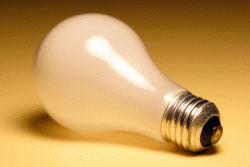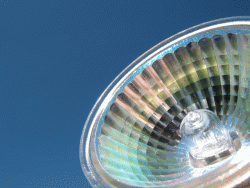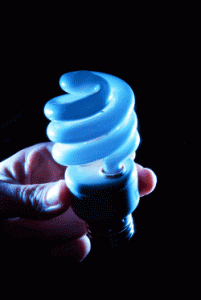Energy Saver Light Bulb: CFLs, LEDs, Halogens and More
An Energy Saver Light Bulb Can Cut Your Lighting Bills By Up To 80%.
With rising energy costs, finding just the right energy saver light bulb is an important part of any home lighting strategy. Although usually only compact fluorescent bulbs are marketed as “energy saver” light bulbs, there are actually a number of different options that you can use to cut down on your electrical bills.
The Basics:
Assuming you don’t want to live in the dark, the primary way of cutting down on your lighting bills is to increase the efficiency of your bulbs. In other words, you don’t want to have your energy saver light bulb to burn any less brightly, but you do want it to use less energy when doing so.
The efficiency of a light bulb is called the bulb’s “luminous efficacy”, or in standard English, how efficient it is at turning energy into light. The unit used to measure luminous efficacy is called “lumens per watt”. “Lumens” is a measure of brightness, so “lumens per watt” is the amount of brightness you get per watt of power.
Different types of light bulb provide different lumens per watt. Note that the below is an average:
| Bulb Type | Lumens Per Watt |
| Incandescent | 15 | Halogen | 20 | Fluorescent | 75 | LED | 75* |
*This number is constantly increasing. See the discussion below.
As you can see, LED and fluorescent bulbs are about five times better energy saver light bulbs than incandescent lights and almost four times better than halogen lights. Just switching over your light bulbs will save you up to 80% on your lighting electricity costs. (Note that it won’t actually reduce your energy bills by 80%, just the portion that goes to lighting).
What’s Wrong With Incandescent Lights?
The problem with incandescent lights is that they are extremely wasteful of the electricity that goes into them. When a current is put through an incandescent light, eighty to ninety percent of that electricity goes directly into heat. Only ten to twenty percent is converted into light. This is simply because of the tungsten filament and what happens when you electrify it. Mostly, it just heats up.

The tungsten filament light bulb has been overwhelmingly the most popular type of bulb for a century.
This can actually increase your energy bills even further if you are using incandescent light bulbs in the summer. Your lighting is actually heating your home, causing your air conditioner to work even harder to then cool it down. So, you’ll actually be wasting even more energy in order to fight against the heating effects of your light bulbs.
Conversely, in the winter, compact fluorescent light bulbs and LED light fixtures will not provide as high an energy savings as they do in the summer, if you are using electric heating. Incandescent light bulbs contribute to the heating of your home. They are not as efficient as other forms of electric heating, but you will find that fluorescent lights won’t save you as much money in the winter.
What About Halogen Light Bulbs?
Halogen light bulbs have a strange history. For a long time, they were slightly whiter and slightly more energy efficient than incandescent light bulbs, and got a reputation as being the “white energy saver light bulb”.

Halogen reflector bulbs create efficiency by not wasting backlight.
The problem is that none of this is true. Halogen light bulbs are still basically pink light and are still terribly energy inefficient. Now that true white light bulbs and highly energy efficient light bulbs are available, it is time for halogen to lose this reputation. Halogen is a great light for providing directed accent light that is flattering for people’s complexions, but it is by no means energy efficient.
Nonetheless, halogen light bulbs can still be energy saver light bulbs if used properly. One of the most common types of halogen light bulb is called a halogen “reflector”. A reflector has a metal mirror on the back of the bulb that directs all of the light forward. In cases where the backlight would otherwise be wasted, a reflector is twice as energy efficient as a light that wastes half of its light.
As a result, when used for spot lighting, a halogen reflector bulb can be about half as efficient as a fluorescent or LED energy saver light bulb. Aside from this exception, though, halogen light bulbs are not as efficient as the newer options.
Fluorescent Lights and CFLs
Fluorescent lights have been around for quite a while, and had a terrible reputation due to poor color distribution, humming and flickering. Fortunately, all of these problems have been resolved, and fluorescent lights now provide just as high quality light as either of the traditional options of incandescent and halogen light bulbs.
Fluorescent lights work by electrifying mercury vapor inside of a tube, which then causes a phosphorescent coating on the inside of the glass to illuminate. This process is highly efficient, converting about 85 to 90 percent of the electricity to light. As a result, you’ll receive much higher lumens per watt when using fluorescent bulbs than using the traditional options.
The type of bulb most commonly marketed as an “energy saver light bulb” is the “CFL” or “compact fluorescent lamp”. These bulbs are designed to fit into any household fixture that traditionally held an incandescent light bulb, and have therefore been highly successful on the market. If your goal is to reduce your energy costs in the quickest and most convenient want, purchasing CFLs is the way to do it.
Be cautious, though, when purchasing them to make sure you get the right color. If you like the appearance of the light you get from your incandescent light bulbs, you might be surprised to find that your new CFLs don’t look the same. That’s because CFLs come in a wider range of colors than incandescent lights. You may either like the new color or purchase bulbs resembling your old colors:
Warm White or Soft White: The same color as incandescents. Great for faces.
Cool White or Bright White: A clearer, white light. Renders colors accurately.
“Natural” or “Daylight”: A bluish light. Looks great on plants, but bad on people.
All of the above colors are available on incandescents, so if you want things to say the same, get a “warm white” or “soft white” bulb.
LED Light Bulbs
An exciting new area of energy saver light bulbs is the LED light bulb. These light bulbs work using semi-conductor technology, allowing electrons to recombine in such a way that they produce light. For many years, these lights were relatively dim and, more importantly, not white. However, in just the past few years, white LEDs have been developed and they are increasingly becoming a part of home lighting design.

LED lights have come a long way since their days on the stock exchange.
LED light bulbs are just as energy efficient as fluorescent light bulbs and the technology behind them is improving all of the time. In May 2010, a light bulb was made commercially available that produces 135 lumens per watt, almost twice as efficient as fluorescent lights. Currently, lights available for the home are about as efficient as fluorescents, but expect LED technology to become increasingly efficient and affordable in the next decade or so.
LEDs have some advantages over fluorescent energy saver light bulbs. First, they produce absolutely no heat and no radiation. This prevents them from damaging finishings and artwork without your home. Second, they are non-toxic. If a fluorescent bulb breaks, you literally need to evacuate for fifteen minutes. LEDs contain no mercury and are often a better choice in areas where there are plenty of children.
The downside of LED bulbs is primarily their cost. LED bulbs cost around fifty to sixty dollars each, almost quadruple what you would pay for a comparable CFL. As a result, if your goal is saving money, it will be a lot longer before an LED pays for itself in energy savings. However, if your goal is to save the environment, LEDs are the best choice. They are highly efficient and don’t have toxic elements.

Home owners are increasingly changing their light bulbs for energy savings.
In a few years, LED lights will reach the point that flat screen monitors did a few years ago and completely wipe their competition off of the map. Aside from cost, there are simply no downsides to LED lighting and that cost continues to drop significantly.
Putting It All Together
There are a number of things to consider when choosing an energy saver light bulb. Ultimately, the goal is to choose the most energy-efficient bulb with the fewest negatives:
- Incandescent and halogen light bulbs are highly inefficient bulbs.
- Fluorescent bulbs are very efficient, though they can be toxic if broken.
- CFLs are the quickest way of increasing efficiency.
- LEDs are highly efficient, but expensive.
For now, CFLs and fluorescents are the best option, but look for LEDs to challenge them in the near future.
